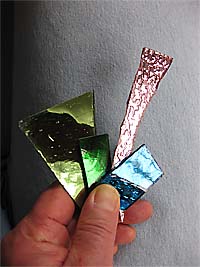The reflective tesserae incorporated in the work of Toby Mason are pieces of colored mirror. Normally, we think of mirror as silvered clear glass in which we can see a reflection. When sheets of brightly colored, irregularly surfaced glass are silvered, the effect is quite different. The tesserae seem to glow as if lit from within. The range of hues and surface variegation are limited only by the glass available. Sheets of silvered traditional art glass, each with unique color vibrancy and surface texture, are hand cut to produce the tesserae. Unlike traditional mosaic material, they offer unlimited variation in size and shape.
Since the mosaics are made of small mirrors, they do reflect a mirror image known as a virtual image.
Like other reflective surfaces, the visual elements change according to the amount of light in
the foreground and the character of the surroundings. However because of the variegation in the
glass surface, one's attention is drawn to the mosaic, not to the foreground reflection. The silvering
makes them glow rather than repeat the environment. They shine in direct sun, and possess a
luminescent quality even in the dimmest light.
Each mosaic also changes in appearance as the observer’s position shifts. This allows one to interact
with the image, to create a whole new feeling in the work itself with only minor movement.
Hot colors give way to cool ones as a slight shift in position causes different pieces and shapes
within the composition to gain or lose emphasis. Detailed works exhibit a shimmer of colored
light along the edges of the pieces, moving as the observer moves. Even the small works make the
light dance.
These changes in emphasis and color make the work kinetic without resorting to contrivance. It
begs an interaction and patrons will dance with the artwork to find the color combinations they
favor. Mirror mosaics are always in motion, even simply as the room’s light changes. It is inherent
in the nature of reflective surfaces to dynamically interact with the environment, and they harmonize
as well. Colors in the vicinity of the works are reflected on their surfaces, binding nearby
colors intrinsically into the composition. The interplay of all these elements provides interest that
keeps the work fresh and alive.
